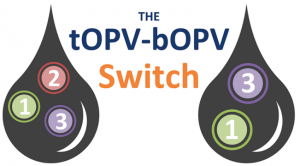Polio-Free World in Sight as Largest Vaccine Rollout in History Kicks Off
155 countries around the world switching from trivalent OPV to bivalent OPV

GENEVA, 14 April 2016 – Next week marks the beginning of the largest and fastest globally coordinated rollout of a vaccine into routine immunization programs in history. Between 17 April and 1 May, 155 countries and territories around the world will stop using the trivalent oral polio vaccine (tOPV), which protects against all three strains of wild poliovirus, and replace it with bivalent OPV (bOPV), which protects against the remaining two wild polio strains, types 1 and 3. This effort will provide better protection for children against polio, particularly those most vulnerable to infection.
This transition, referred to as the global vaccine “switch,” is possible because type 2 wild polio has been eradicated. The switch has been recommended by the Strategic Advisory Group of Experts on Immunization and endorsed by the World Health Assembly as a critical component of the polio endgame strategy.
“We’re closer than ever to ending polio worldwide, which is why we are able to move forward with the largest and fastest globally synchronized vaccine switch ever,” said Michel Zaffran, Director of Polio Eradication at the World Health Organization. “It is a massive undertaking, but it is testimony to how much progress is being made toward achieving a lasting polio-free world and to the commitment of all countries to make this dream a reality.”
The oral polio vaccine (OPV) has been used to stop polio in most of the world. On very rare occasions in under-immunized populations, the live weakened virus contained in OPV can mutate and cause circulating vaccine-derived polioviruses (cVDPV). More than 90% of cVDPV cases in the last 10 years have been caused by the type 2 vaccine strain. Withdrawing tOPV and replacing it in routine immunization programs with bOPV will eliminate the risks associated with the type 2 vaccine strain and, just as importantly, boost protection against the two remaining wild strains of the virus.
The switch must be globally synchronized because if some countries continue to use tOPV it could increase the risk of the spread of type 2 poliovirus to those no longer using tOPV. The switch is the first major step toward the eventual removal of all OPV after wild polio transmission has been stopped.
“This is an extremely important milestone in achieving a polio free world,” said Reza Hossaini, Chief of Polio at UNICEF. “Hundreds of thousands of vaccinators and health workers have been trained for the switch to happen quickly and effectively, so that children everywhere can be protected from this devastating disease.“
To ensure that the switch takes place as planned, thousands of independent monitors will confirm the absence of tOPV at public and private service facilities and cold chain stores.
“The switch is a massive undertaking and is only possible due to the tremendous collaboration of country governments, GPEI partners, and the independent monitors. It is another example of the program moving in the right direction toward global eradication,” said Jay Wenger, Director of the Polio Program at the Bill & Melinda Gates Foundation.
In countries at higher-risk of a polio outbreak, a dose of inactivated polio vaccine (IPV) has been added to routine immunization schedules, in addition to bOPV, to further boost immunity. To protect against the very small risk of an outbreak of cVDPV type 2 after the switch, a global stockpile of monovalent OPV (mOPV) type 2 is ready to be dispatched if an outbreak occurs.
“The stockpile of mOPV type 2 is like an insurance policy in case there is an outbreak,” said Stephen Cochi, Senior Adviser to the Director of the Centers for Disease Control and Prevention’s Global Immunization Division. “A lot of time has been spent evaluating the possible risks and minimizing them.”
The switch is a significant milestone in the effort to achieve a polio-free world. In 2015, there were fewer cases reported in fewer countries than ever before. This year, the focus is on reaching every child with the polio vaccine and stopping the virus in its final strongholds. In order for that to happen, donors must continue to invest in the eradication effort.
“When Rotary started the campaign to end polio, more than 350,000 children were paralyzed every year by this deadly virus,” said Michael K. McGovern, Chair of Rotary’s International PolioPlus Committee. “This switch is an important step, but we must maintain our support until every last child is safe from this disease.”
Oliver Rosenbauer, World Health Organization; +41 79 500 6536; rosenbauero@who.int
Francesca Heintz, Global Health Strategies; +1 914 588 0823; fheintz@globalhealthstrategies.com
John Butler, Global Health Strategies; +1 917 573 1339; jbutler@globalhealthstrategies.com
The Global Polio Eradication Initiative is spearheaded by national governments, WHO, Rotary International, the US Centers for Disease Control and Prevention (CDC) and UNICEF, and supported by key partners including the Bill & Melinda Gates Foundation. Since 1988, the incidence of polio has been reduced by more than 99.9 percent. At the time, more than 350,000 children were paralyzed every year, in more than 125 endemic countries. Today, only two countries remain that have not stopped endemic transmission of wild polio: Pakistan and Afghanistan. In 2015, 74 cases of wild poliovirus and 32 cases of circulating vaccine-derived poliovirus were recorded.













